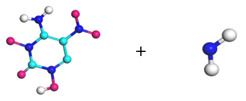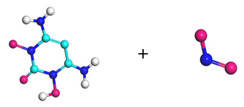Table 2.
Detailed initial reaction pathways in the decomposition of the three models at different temperatures. The cyan, white, blue and red spheres stand for C, H, N, and O atoms, respectively.
| Path No. | Type | Reactant | Product |
|---|---|---|---|
| Path 1 | Intramolecular H transfer |

|

|
| Path 2 | Intramolecular H transfer |

|

|
| Path 3 | Intermolecular H transfer |

|

|
| Path 4 | Intermolecular H transfer |

|

|
| Path 5 | Small moleculeformation (OH) |

|

|
| Path 6 | Small moleculeFormation (NH2) |

|

|
| Path 7 | Small moleculeformation (NO2) |

|

|
| Path 8 | Small moleculeformation (NH2) |

|

|
| Path 9 | Small moleculeformation (H) |

|

|
| Path 10 | Small moleculeformation (H) |

|

|
| Path 11 | Small moleculeformation (H2O) |

|

|
| Path 12 | Ring breakage (C-N) |

|

|
| Path 13 | Ring breakage (C-N) |

|

|
| Path 14 | Ring breakage (C-N) |

|

|
| Path 15 | Ring breakage (C-N) |

|

|
| Path 16 | Rearrangement of –NO2 |

|

|
| Path 17 | Bimolecular polymerization |

|

|
